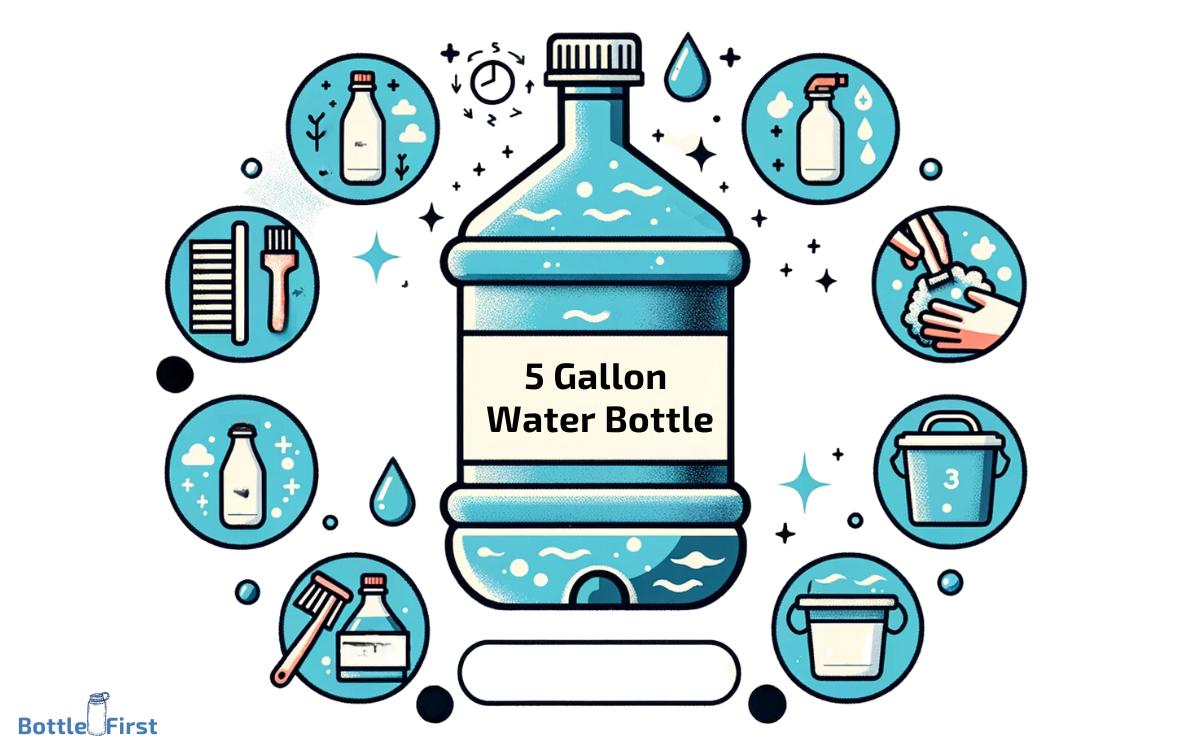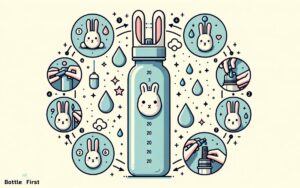How to Remove Algae from 5 Gallon Water Bottle? 8 Steps!
To effectively remove algae from a 5-gallon water bottle, one should apply a combination of mechanical cleaning and disinfecting agents.
Begin by emptying the water bottle and using a bottle brush with a mixture of warm water and vinegar or baking soda to scrub away the algae physically. Rinse thoroughly.
For disinfection, consider using a diluted bleach solution (1 tablespoon of bleach per gallon of water), letting it sit for several minutes, and then rinsing the bottle several times to remove any residual bleach.
An alternative is to use hydrogen peroxide as a disinfectant. After cleaning, ensure the bottle is completely dry before refilling it with water to prevent algae regrowth. Algae can thrive in water bottles due to light exposure and the presence of nutrients.
Here are the quick steps and options for cleaning:
- Empty the bottle and discard the contaminated water.
- Mix a natural cleaning solution (1:1 ratio of water to vinegar or a few tablespoons of baking soda with water).
- Use a bottle brush to scrub the inside of the bottle.
- Rinse the bottle thoroughly with clean water.
- For disinfection, use a bleach solution (1 tablespoon of bleach per gallon of water) or hydrogen peroxide (a few drops per gallon).
- Let the disinfectant sit for a few minutes, then rinse the bottle multiple times.
- Air-dry the bottle upside down in a clean area.
Ensure your 5-gallon water bottle remains algae-free with these simple yet effective cleaning techniques, safeguarding your water’s taste and quality.

Key Takeaway
Understanding Algae Growth in Water Bottles

Algae growth in water bottles occurs over time due to the presence of sunlight and nutrients in the water. When exposed to sunlight, algae utilize the nutrients present in the water to thrive and multiply.
This natural process can be accelerated by warm temperatures, creating an ideal environment for algae to flourish.
The combination of light and nutrients fosters the perfect conditions for algae to form and spread within the water bottle. Understanding the factors that contribute to algae growth is crucial in developing effective strategies for prevention and removal.
By comprehending the mechanisms behind algae proliferation, innovative solutions can be devised to address this issue.
Now, let’s delve into the essential methods for proper cleaning and maintenance to prevent and eliminate algae in water bottles.
Step 1: Proper Cleaning and Maintenance

In order to ensure the longevity of your 5-gallon water bottle and to prevent the growth of algae, proper cleaning and maintenance are crucial.
This includes implementing effective algae prevention tips and utilizing specific cleaning techniques to remove any existing algae.
Algae Prevention Tips
To prevent algae growth in a 5-gallon water bottle, regular cleaning, and proper maintenance are essential.
Start by washing the bottle with a mixture of hot water and a small amount of dish soap, using a long-handled brush to scrub the interior. Rinse thoroughly to remove all soap residue.
After cleaning, ensure the bottle is completely dry before refilling it with water to prevent algae from forming.
Store the bottle in a cool, dark place away from direct sunlight, as algae thrive in sunlight. Consider using a bottle with a dark tint to further block out light.
Lastly, replace the water every 1-2 weeks to prevent stagnation and the growth of algae. By following these preventative measures, you can maintain a clean and algae-free water bottle.
Cleaning Techniques for Algae

Proper cleaning and maintenance are crucial in preventing algae growth in a 5-gallon water bottle. As discussed in the previous section on algae prevention tips, innovative cleaning techniques are essential.
To effectively remove and prevent algae, there are several steps you can take. Firstly, use a long-handled bottle brush with soft bristles to scrub the interior of the bottle. Make sure to reach all corners and crevices.
Next, rinse the bottle with a solution of one part bleach to nine parts water. Thoroughly cover the entire interior surface with the solution.
After allowing the solution to sit for a few minutes, thoroughly rinse the bottle with clean water. This will ensure that any remaining bleach is removed.
In addition to these cleaning techniques, you may want to consider using specialized algae-preventing products or UV-C light sterilization to maintain a clean environment within the bottle.
Regularly repeating these cleaning techniques will help to ensure that algae growth is kept at bay, providing clean and safe water.
Step 2: Using Natural Cleaning Solutions

When it comes to removing algae from a 5-gallon water bottle, natural cleaning solutions can be an effective and eco-friendly option.
Vinegar, for instance, is known for its ability to combat algae growth, while a baking soda solution can help scrub away stubborn algae stains.
Additionally, the citric acid in lemon juice can also be used to naturally clean and disinfect the bottle, making it a versatile option for algae removal.
Vinegar for Algae
Vinegar, a natural and eco-friendly cleaning agent, can be remarkably effective in removing algae from water bottles. The acetic acid in vinegar has been proven to inhibit the growth of algae and kill existing algae due to its acidic nature.
To use vinegar for algae removal, simply pour a mixture of equal parts white vinegar and water into the water bottle, ensuring that all affected areas are covered. Let the solution sit for a few hours, then thoroughly rinse the bottle with clean water.
For stubborn algae, a gentle scrub with a bottle brush can further aid in removal. This natural cleaning solution provides an innovative and safe method for maintaining a clean and algae-free water bottle.
Baking Soda Solution

An effective natural cleaning solution for removing algae from a 5-gallon water bottle is a baking soda solution. Baking soda, or sodium bicarbonate, is a mild alkali that can effectively combat algae growth.
To use this solution, mix two tablespoons of baking soda with warm water and pour it into the water bottle.
Swirl the solution around, ensuring it comes into contact with all interior surfaces, and let it sit for at least 30 minutes. Afterward, thoroughly rinse the bottle with clean water.
Baking soda’s gentle abrasive nature helps to dislodge algae, while its alkaline properties create an inhospitable environment for further growth. This natural approach is not only eco-friendly but also safe for use around food and beverages.
Transitioning from using baking soda, let’s explore the efficacy of lemon juice cleaning in tackling algae buildup.
Lemon Juice Cleaning
Utilizing natural cleaning solutions for algae removal, lemon juice can be employed as an alternative method for maintaining the cleanliness of a 5-gallon water bottle, periodically supplementing the efficacy of the baking soda solution.
The citric acid in lemon juice acts as a natural disinfectant and helps to break down algae and other organic matter, leaving the bottle clean and odor-free.
To use lemon juice for cleaning, follow the steps below:
| Steps | Instructions |
|---|---|
| Step 1 | Empty the water bottle. |
| Step 2 | Fill the bottle with a mixture of equal parts lemon juice and water. |
| Step 3 | Let the solution sit for 15-30 minutes, then scrub the interior with a bottle brush. |
| Step 4 | Rinse the bottle thoroughly with clean water before refilling. |
Step 3: Implementing Regular Sunlight Exposure

Regular exposure to sunlight is essential for preventing algae growth in 5-gallon water bottles. Sunlight not only inhibits algae formation but also helps to eliminate existing algae.
Placing the water bottle in direct sunlight for a few hours each week can significantly reduce the likelihood of algae developing.
Sunlight exposure disrupts the photosynthesis process of algae, hindering its ability to thrive. This natural and innovative method is an effective way to maintain a clean and algae-free water bottle without the need for harsh chemicals or excessive cleaning.
Step 4: Utilizing Hydrogen Peroxide Treatment

To effectively remove algae from a 5-gallon water bottle, one can use hydrogen peroxide treatment. Hydrogen peroxide is a powerful oxidizing agent that can effectively kill algae and prevent its regrowth.
Here’s a simple and innovative method to utilize hydrogen peroxide for algae removal:
| Steps | Materials Needed | Time Required | Benefits |
|---|---|---|---|
| Empty the water bottle | Hydrogen peroxide | 10 minutes | Efficient algae removal |
| Rinse the bottle with water | Water | 5 minutes | Safe for the environment |
| Pour hydrogen peroxide | Scrub brush | Prevents future algae growth | |
| Let it sit for 5-10 minutes | Preserves water quality |
Using hydrogen peroxide treatment not only removes algae effectively but also ensures the water in the bottle remains clean and safe for consumption.
Step 5: Consideration of Bottle Material

The consideration for bottle material is crucial when implementing the hydrogen peroxide treatment for removing algae from a 5-gallon water bottle. The choice of bottle material can significantly impact the effectiveness of the treatment.
Transparent plastic bottles, such as those made from PET (polyethylene terephthalate), are commonly used for water storage and are generally suitable for hydrogen peroxide treatment.
However, if the bottle is made from a different type of plastic, it’s important to ensure that it is compatible with the treatment and won’t react adversely to hydrogen peroxide.
Some materials may be more prone to algae growth due to their porous nature or ability to retain moisture. Understanding the composition of the bottle material is essential for the success of the algae removal process.
Transitioning into the subsequent section about ‘preventive measures for future algae growth,’ it’s important to address long-term solutions that consider the bottle material and its impact on algae prevention.
Step 6: Preventive Measures for Future Algae Growth

When considering preventive measures for future algae growth in a 5-gallon water bottle, it is essential to focus on maintaining cleanliness and inhibiting conditions favorable to algae development.
To prevent algae growth, consider using opaque or tinted water bottles that can block out light, as algae require sunlight for photosynthesis.
Regularly cleaning the bottle with a diluted bleach solution or using specialized algae-inhibiting products can help maintain a sterile environment.
It’s also important to store the water bottle in a cool, dark place to minimize temperature and light exposure.
Replacing the water regularly and avoiding leaving the bottle unused for extended periods can prevent the buildup of organic matter that fuels algae growth.
Conclusion
In conclusion, the removal of algae from a 5-gallon water bottle requires proper cleaning and maintenance.
This includes the use of natural cleaning solutions, regular sunlight exposure, and hydrogen peroxide treatment.
Consideration for bottle material is important in preventing algae growth. By implementing these methods, the water bottle can be kept clean and free from algae.
This ensures safe and healthy drinking water for users. It is important to remember that prevention is better than cure.






